Hunting Wood Ducks: Low Tech, Low Budget, High Excitement
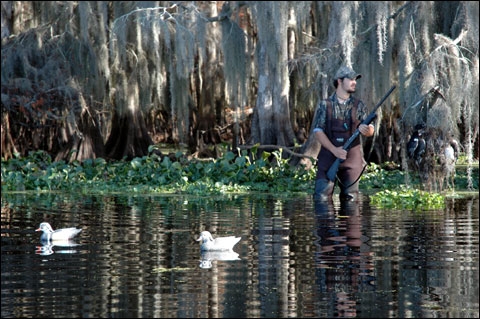
Well before dawn, the camouflage-clad hunter stepped off the gravel road running through the wildlife management area in eastern South Carolina and followed a small creek into the forest.
The creek opened into a shallow flooded oak grove about 100 yards from the road. There, leaning against an oak tree to break up his outline, he loaded his shotgun and waited. Spirals of wispy fog seemingly oozed from the patches of moist ground into the chilled dark air.
As the not-yet-risen sun barely brightened the eastern sky he began hearing swiftly beating wings buzzing unseen overhead. With two more minutes to legal shooting hours, ghostly gray and black comets already whistled through the treetops at breakneck speed. They appeared suddenly and vanished in seconds.
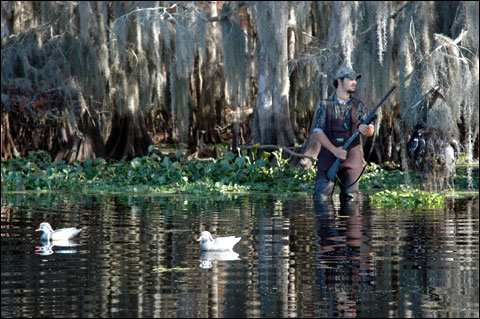
Daniel Felsher waits for more ducks to come into range during a hunt in a cypress swamp near Deland, Florida.
Time! With muscles taunt, he strained to see what created such shrill whistling sounds coming his way. There, just in front of him, a dozen shrieking, twisting shapes materialized briefly between an opening in the trees. He fired and fired again at the disappearing specters without effect.
More shapes flashed past him from the same direction and vanished, seeming to dodge his every shot. Others rocketed overhead before he could reload. He jammed one shell into his Remington 870 pump shotgun. Fire erupted from the muzzle in the gray half-light of a new dawn when he fired at fleeing blips before fumbling for extra shells as more birds appeared from nowhere. The best opportunities to score a hit always passed as he reloaded again and again.
Soon, nearly a box of spent shell casings floated in ankle-deep water or rested atop tiny ice sheets. At last, a lone duck twisting and darting low between the trees appeared in range. The hunter fired three times, finally connecting.
The duck splashed down through the thin ice crystals floating on the water surface at the end of the flooded hardwood basin 40 yards away. Suddenly, the skies seemed devoid of life. Only an occasional pileated woodpecker punctuated the stillness with its raucous cry and telltale hammering on some dead stump. The hunter glanced at his watch. Barely 10 minutes had passed since shooting hours began and already the morning flight faded into memory.
The hunter warmed his frigid hands by cupping them close to the glowing gun barrel and then went to retrieve his prize. As he approached the bird, a glint of sunlight breaking the horizon illuminated the damp iridescent hues of a magnificent drake wood duck. It would look superb mounted in his den. He still had time to go home, shower and make it to work on time. Maybe tomorrow, he’ll hunt again.
Although waterfowlers occasionally bag them in salt marshes or bays, wood ducks prefer quiet freshwater rivers, swamps, green-tree reservoirs, coves of large impoundments, secluded forest ponds, upland creeks, beaver ponds, agricultural stock tanks, oxbow lakes, sluggish bayous and any other type of slow-moving shallow freshwater system. In good areas, wood ducks typically provide fast, furious shooting as flocks fly at first light (or earlier) from their roosting areas to feeding areas, but the flights may only last a few minutes. Often, evening flights don’t even begin until after legal shooting hours, making them extremely difficult to hunt in the afternoon.

Daniel Felsher waits for wood ducks to come into range during a hunt in the Mobile-Tensaw River Delta near Mobile, Alabama.
When making daily flights toward their early morning and evening destinations, woodies frequently fly in small, loose flocks or pairs. Swift flyers with large whitish breast feathers, wood ducks fly with their bills pointing slightly down and their necks not fully extended, unlike other ducks. Noisy birds, wood ducks make distinctive whistling sounds while flying. In the dim light at dawn, hunters frequently hear wood ducks long before they arrive within shotgun range. Because of their striking markings, distinctive sounds and flight patterns, hunters can easily recognize woodies, even in low light conditions.
Wood ducks generally fly the same patterns throughout the year and continue to use good routes year after year. Almost like deer using trails, woodies often use the same streams, bayous and rivers as navigation highways and landmarks. In the spring, summer or early fall, many sportsmen watch for resident birds when fishing rivers or lakes with good wood duck populations.
Woodies also use natural breaks in tree lines the way mountain climbers use valleys and passes. Through a tree break, places where trees thin or younger trees create dips in the skyline, ducks might drop to a lower altitude, offering waterfowlers better shots at the fast-moving birds. Their predictability gives sportsmen an advantage over the birds. With a little scouting and planning, hunters who position themselves in the right spot can shoot almost continuously at wave after wave of ducks zipping overhead for as long as the morning flight lasts.
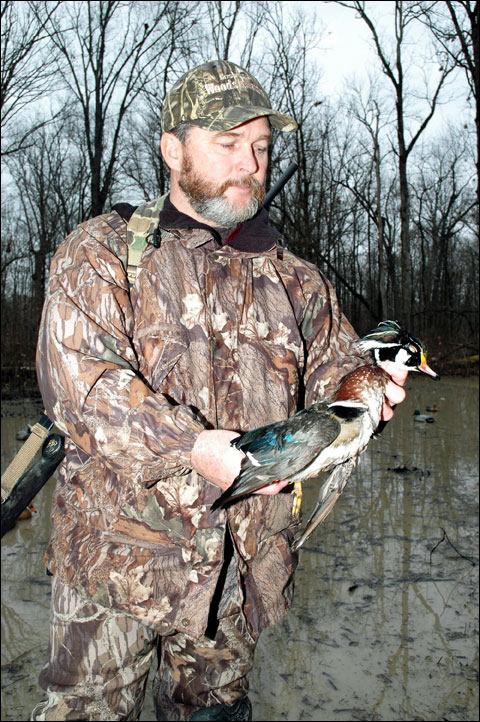
Mike Giles admires a wood duck drake he killed while hunting in a flooded timber pothole near Stuttgart, Arkansas.
“The most important thing about hunting wood ducks is scouting, before and during the season,” advised Ed Penny, waterfowl coordinator for the Mississippi Department of Wildlife, Fisheries and Parks in Jackson. “Look for isolated sloughs and pockets of water that can offer good shooting. Also look for food sources like acorns and natural plant seeds. Find the food and you’ll find the ducks. When scouting, look for feeding or roosting areas and hide between those areas.”
When scouting, look for small clearings along a transition zone between feeding and roosting areas. Woodies feed on a variety of nuts, berries, fruits, wild grasses, sedges and seeds. Among all foods, they prefer white oak acorns, swallowing them whole. The dabbling ducks frequently feed where overhanging oaks drop their precious protein cargo into shallow water. Where an oak ridge meets a swamp could provide an excellent place to ambush wood ducks.
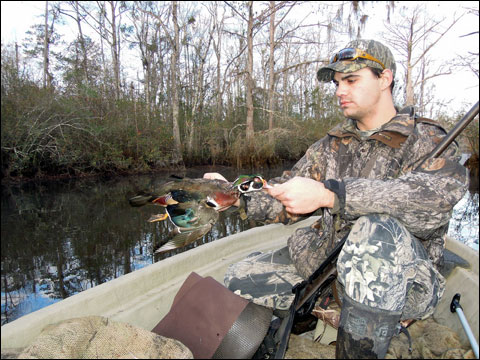
A wood duck drake shot while hunting in the Mobile-Tensaw River Delta near Mobile, Alabama.
Many sportsmen hunt wood ducks from boats equipped with pop-up blinds. However, in the right spot, hunters don’t really need blinds at all. Simply hide against a dark background and remain motionless. In dim light, ducks cannot see sportsmen very well, especially those remaining still and hiding against a broken, dark background. By the time woodies can see a sitting boat or a hunter standing in timber, the morning flight typically ends anyway. However, hunters often don’t see wood ducks until the last second either. Upon recognition, hunters often must acquire targets and fire in seconds.
Even without a blind, small, camouflaged flatboats make excellent shooting platforms. They also aid in scouting. Light and maneuverable, they can penetrate thick cover where larger boats cannot go. When pushed against dark backgrounds and covered with brush, moss or camouflaged netting, their low silhouettes make them difficult to see in dim light.
Cover any bright object, like outboard motors, with camouflaged or dark cloth. Position boats against overhanging bushes or trees with a bayou, pond or river channel in front. This open area allows better visibility and shooting. The backside of a river bend offers an excellent place to set up an ambush. Woodies frequently fly between trees down the middle of a stream. Ducks coming around the bend won’t see the boat until almost on top of it.
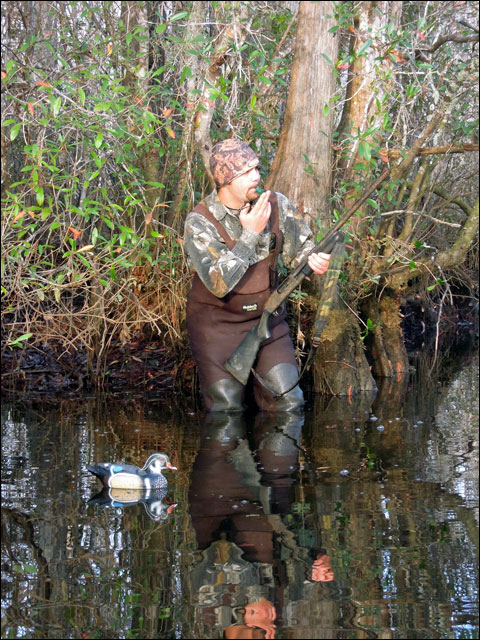
Daniel Felsher calls ducks into range during a hunt in the Mobile-Tensaw River Delta near Mobile, Alabama.
“Hunting out of a boat is comfortable,” said Mike Caruthers, a duck hunter from Vicksburg, Miss. “We have to be mobile when hunting ducks on a river. We can get up and move to find ducks and set up in a few minutes. Because we can move easily, we can keep up with the birds as they move up and down the river.”
Wood duck hunters don’t need decoys for pass shooting either. Woodies seldom decoy well anyway. Wood ducks fly their pre-determined travel routes regardless of what might wait underneath and crash-land in heavy brush wherever they feel like it. Tiny black and gray objects often virtually materialize instantaneously and flash pass startled hunters like jet fighters on afterburners and drop into whatever cover they desire.
Whistling, darting and zigzagging between trees like oversized woodcock, wood ducks make exceptionally challenging targets. In pass shooting without decoys, hunters often must take shots at long ranges, so use magnum loads and a shotgun with reach. In dense forests, ducks may fly above the trees. A full choke with Number 2 to 4 steel shot or Number 6 or 5 Hevi-Shot typically works best to bring down the swift, handsome birds. In tight situations, like flooded timber or a small creek that offers limited visibility, sportsmen may want to use open chokes to hit the swift and erratic fliers.
Since woodies fly so early and so briefly, hunters can frequently expand their hunting time by jumping birds after the morning frenzy ends. Federal laws prohibit hunters from shooting waterfowl from moving boats under power – including electric motors and sails — but waterfowlers can jump-shoot birds from canoes, kayaks and other paddle-powered craft.
After woodies stop flying, paddle through tiny sloughs, ponds and creeks looking for birds. Use the same basic stalking methods of stopping, looking and listening that works well for other game, but with an aquatic adaptation. With a shotgun handy, dip the paddle silently in the water and keep it in the water as much as possible because water dripping off paddles can alert wary ducks over long distances. Sound travels easily and far over water, especially on still mornings.

A hunter shows off a drake wood duck he killed while hunting a swamp near Eufaula, Alabama.
In very shallow, hard-bottomed creeks, boaters can use paddles almost like push poles, sculling along without lifting them from the water. When coming around bends, take the inside curve, using the shoreline to mask movement. Hug shorelines as closely as possible for maximum cover. Stay alert for any sound or movement.
When hunting with others, designate one shooter and take turns for safety reasons. The person in the rear of the boat acts as a spotter and paddler. Only the designated shooter in the bow should hold a loaded gun at ready.
Wary masters of concealment, a flock of wood ducks may erupt from a creek or slough anywhere. Sometimes, they flush a hundred yards from an approaching boat. At other times, unseen ducks explode from tangled logjams and flooded brambles almost under the noses of startled hunters. Always, they pierce the swamp with their shrill cries. Either way, sneaking up on wood ducks and getting a shot offers one of the most intense challenges in duck hunting.
In many areas sportsmen who don’t own boats can still hunt wood ducks simply by hiding among trees and bushes in soggy bottomlands or near ponds, creeks or sloughs under a good flight route. After the early flight ends, waterfowlers on foot can go looking for more woodies. Especially effective in limited water areas, land-based sportsmen can jump ducks by walking slowly along upland creeks or pond shorelines.
Watch where the early fliers headed and venture off in that direction if possible. Often, birds might follow small sluggish streams that may eventually lead to beaver ponds or other larger water bodies containing feeding or resting ducks. Stalk slowly and quietly along the creek shoreline and prepare for sudden action.
Wary woodies can pinpoint hunters from a considerable distance. Stop frequently, look and listen. Watch for movement. Look for rippling water in normally placid pools. Listen for whistling, splashing or other sounds. Look under overhanging trees and behind logs. Wood ducks can hide almost anywhere and often seek quiet water in heavy cover as protection from airborne predators like hawks. Don’t discount even the smallest water. These puddle ducks don’t need much. Woodies may explode in a startling rush of water and wing beats from small puddles and streams. Like woodcock, they quickly disappear in darting, twisting paths through trees that would seem difficult for a gnat to navigate.
One of the few ducks that can land in trees, woodies nest in cavities, above countless predators. Extensive logging of ancient cavity-filled trees nearly wiped out the wood duck population early in the 20th century. To supplement natural holes, state conservation agencies and private organizations built an extensive network of artificial nesting boxes in swamps, lakes and sloughs throughout its range in the past few decades. Consequently, these colorful little speedsters rebounded remarkably, a true wildlife management success story.
Now, among the most regionally common ducks in the Mississippi and Atlantic Flyways, wood ducks flourish in the eastern United States. Wood duck numbers rose to become the second most common duck behind mallards in many parts of the United States. Some wood ducks migrate and some stay in their favorite Southern swamps throughout the year. Some spend their summers in the Mid-West, Middle South or northeastern states and migrate to the Gulf and southern Atlantic coasts each winter.
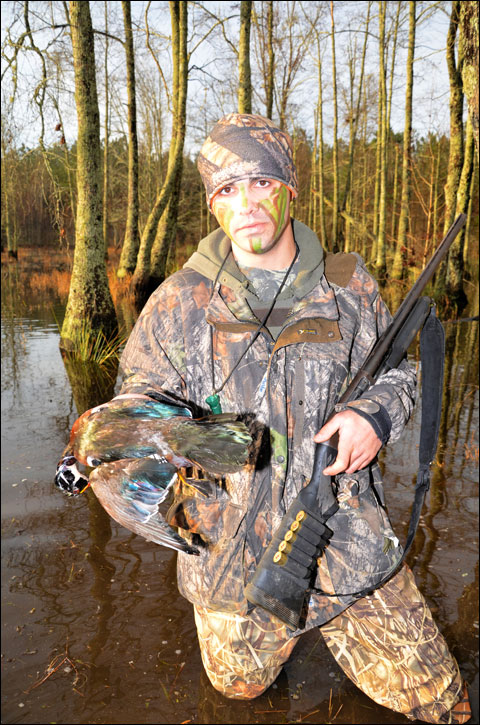
Daniel Felsher shows off a drake wood duck he killed while hunting a swamp near Eufaula, Alabama.
“In most years, wood ducks are the second most common bird taken by Mississippi hunters,” Penny advised. “Mississippi and other southern states usually have large resident breeding populations of wood ducks, but they get birds migrating in from other states as well during the winter.”
Not every hunter enjoys access to coastal marshes, bays or lakes or can afford to join an expensive duck lease. Not every hunter can afford the boats, blinds and decoys it normally takes to hunt ducks. However, nearly every hunter in the southeastern United States can take an exciting crack at fast-flying wood ducks close to home with little investment.
With just a reliable shotgun, plenty of ammunition, camouflaged clothing and a good set of hip boots or waders, hunters can enjoy outstanding, if brief, shooting for one of the most familiar and handsome waterfowl in North America. Abundant and widespread, woodies provide outstanding waterfowl action close to home for those on a low budget.
John N. Felsher is a full-time award-winning freelance writer, photographer and media consultant with more than 2,100 bylined articles in more than 135 magazines to his credit. Listen to John on the Outdoors radio show live from noon to 1 p.m. Central every Thursday on WNSP Sports Radio 105.5 FM in Mobile, Alabama and on Alabama’s Great Days Outdoors radio on multiple stations throughout Alabama every Saturday. Visit his web site “John N. Felsher’s Outdoors Adventures” at http://www.johnnfelsher.com .

John N. Felsher is a professional freelance writer, broadcaster, photographer and editor. An avid sportsman, he’s written more than 3,500 articles for more than 170 different magazines on a wide variety of outdoors topics. He also hosts an outdoors tips show for WAVH FM Talk 106.5 radio station in Mobile, Alabama. Contact him at j.felsher@hotmail.com or through Facebook.


Comments